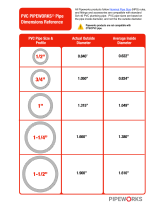Page is loading ...

P/N MMI-20020569 Rev AB © 2011 Micro Motion, Inc. All rights reserved. The Micro Motion and Emerson logos are trademarks and service marks of Emerson Electric Co. Micro Motion, ELITE, MVD,
ProLink, MVD Direct Connect, and PlantWeb are marks of one of the Emerson Process Management family of companies. All other trademarks are property of their respective owners.
Bunkering Procedure for Compliance with OIML/MID Accuracy Requirements
Barges with Micro Motion® Certified Marine Bunker Measurement Solution
All standard setup and safety procedures must be followed at all times.
IMPORTANT! Failure to follow the procedures specified in this document may result in a measurement that is not
OIML/MID-approved.
This procedure is designed for use with the detailed operational procedure in the Marine Bunker Transfer Package Application Manual.
Refer to the detailed operational procedure as required.
Before Bunkering
1. Present all relevant documents (procedures, fuel specifications, and estimated quantity) to the purchaser/vessel.
2. Obtain the barge-specific MID compliance document, as delivered by Emerson at the end of the certification process. This document includes the Process & Instrumentation
Diagram between meter and transfer point (P&ID), all permanent and temporary sealings, provisions to check for leakage (e.g., sight glasses), operational procedures, and
maintenance procedures.
3. Ensure that the pressure gauge at the bottom of the discharge arm reads atmospheric pressure. If it does not, take action to drain the discharge arm (pressure should read
atmospheric).
4. Supplier/barge captain and vessel chief engineer must verify the following, as defined in the barge-specific MID compliance document:
• All permanent seals, as attached by the authorized officer, are intact.
• All temporary seals (each identified with a unique number) are in place.
• All sight glasses are clean.
Proceed to the next step when all conditions are met.
5. If requested by vessel chief engineer, verify compliance with the barge-specific P&ID included in the barge-specific MID compliance document.
6. Supplier/barge captain and vessel chief engineer must verify that both of the following conditions are true at the flowmeter display:
• The value of the mass totalizer is 0 or the site-specific value defined in the barge-specific MID compliance document.
• No alarm is active.
If both conditions are met, the flowmeter is ready for bunker transfer. If the conditions are not met, print a bunker ticket and retain the ticket for traceability. If the alarm
remains, or the mass total is not reset to 0 or the site-specific value, consult the manual for troubleshooting information. If you cannot resolve the situation, contact Micro
Motion at [email protected]
.
7. Barge captain should take all appropriate actions to minimize the amount of air passing through the flowmeter before fuel delivery begins. For example, fill all the pipeworks
between the barge tanks and the flowmeter (recirculate with no bunker fuel passing through the sensor).
8. Open the main bunker manifold valve of the vessel.
9. Start bunkering as soon as possible. The flowmeter will begin bunker totalizing as soon as fuel oil is pumped through the flowmeter.
During Bunkering
During the bunker transfer, the flowmeter calculates and displays the Aeration Limit diagnostic. Aeration Limit is the measured aeration of the fuel, reported as a percentage of the
maximum allowable value. Aeration Limit is not reported until the quantity transferred reaches MMQ (Minimum Measured Quantity). At the beginning of the bunker, Aeration Limit
will be high and possibly increase due to air in the pipelines. Once the pipelines are full of liquid, Aeration Limit should decrease and become lower than 100%. During the emptying
of the barge tank(s), Aeration Limit will increase.
1. Take all possible measures to reduce/eliminate air entrainment throughout the bunkering process.
2. Monitor the Aeration Limit diagnostic throughout bunkering. If the value of Aeration Limit is 100% or greater at the end of the transfer, the bunker measurement will not meet
MID requirements. Depending on system installation, audible/visible alarms may be triggered at predefined threshold values of Aeration Limit (default values are 20% and
75%).
IMPORTANT! If the value of Aeration Limit is greater than 100% and is not decreasing, increase the back pressure downstream from the flowmeter. If this does not correct the
problem, take all available measures to eliminate the aeration source. However, if the heavy fuel in the barge tanks is already aerated before start of the bunkering, Aeration
Limit will not decrease and the bunker measurement will not meet MID accuracy requirements.
Best practice: Manage the bunker transfer so that Aeration Limit is 25% or less at the end of the transfer.
3. IMPORTANT! Close the main bunker manifold valve as soon as the required amount has been delivered. Follow the defined procedure to drain the line, including the
discharge arm (blow the line and/or drain the line back to the tanks).
After Bunkering
1. Upon completion of bunker delivery, supplier/barge captain and vessel chief engineer must check the sight glass(es), verify that the pressure gauge near the flowmeter reads
atmospheric pressure, verify that all seals are intact, then press the Print button and witness the printing of the bunker ticket from the Marine Bunker Transfer Package. The
printed ticket includes the mass of the bunker and the OIML/MID pass/fail result. For a valid measurement, all four of the following must be true: The OIML/MID result on
the ticket must be Pass; the sight glasses must be clean; the pressure reading at the bottom of the discharge arm must be atmospheric; and all seals must be intact. If one or
more of these conditions is not true, the measurement is not valid.
2. Supplier/barge captain must provide the Bunker Delivery Note (BDN) to the vessel chief engineer. The vessel chief engineer must compare the BDN with the ticket.
/

